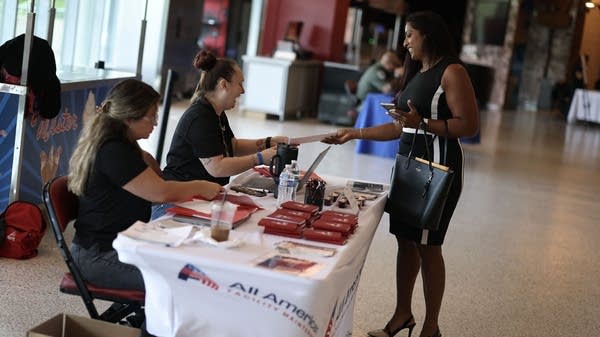The FAA wants to hire more air traffic controllers, but that won’t happen overnight
There’s been a shortage of controllers for years.

While the Trump administration has been cutting thousands of jobs from the federal workforce, it’s also been trying to hire more of one particular type of federal worker: air traffic controllers.
The Federal Aviation Administration has dealt with a shortage of controllers for years, and the agency has said it hopes to hire 2,000 of them this year.
To do that, it boosted pay for some controllers in training, and simplified parts of the hiring process. But it may take a while for those efforts to produce results.
Already, the job of directing planes in and out of airports and through the skies comes with some financial perks.
“By the time you're 26 you can make a pretty substantial six-figure salary,” said Stephen Abraham, who retired after 23 years as a controller at John F. Kennedy airport in New York City. “When you retire at age 56, you get this magic thing that nobody else can offer you now called a pension.”
The trade off? The job is stressful.
“I make 5,000 decisions a day at work, and all of them have to be right,” Abraham explained. “You really kind of don't get a second chance.”
Do that five or six days a week on shifts that sometimes start and end at different times every day, and the mental strain and fatigue adds up.
“It just wears you out,” Abraham said. That’s one reason why most air traffic controllers have to retire at age 56.
Early retirements and the strains of the work itself help explain why the Federal Aviation Administration is about 3,500 air traffic controllers short of its staffing target, per Reuters.
The FAA did not agree to a recorded interview for this story, but in a written statement it said that growing the controller workforce is “a top priority for the FAA.” It also highlighted that more than 8,300 people recently qualified to take an aptitude test, which is an early step in the process of becoming a controller.
But getting someone from the aptitude test to working in a control tower means passing through some bottlenecks in the system.
“The FAA’s academy in Oklahoma City can only handle 1,800 students per year running at full capacity,” said Michael McCormick, coordinator of the air traffic management program at Embry-Riddle Aeronautical University in Florida.
Until last year, all future controllers had to go through the Oklahoma academy, even those with undergraduate air traffic degrees from schools like Embry-Riddle. Last year, the Biden administration moved to alleviate that bottleneck: It allowed some undergraduate programs to offer equivalent training, through an effort known as the Enhanced Air Traffic Collegiate Training Initiative. Now, at five schools, including Embry-Riddle, students can be hired by the FAA immediately after graduation, McCormick said.
The Trump administration has added more air traffic control programs to the effort, and even more schools could qualify. The University of North Dakota joined the program earlier this year.
Craig Carlson, an associate professor there, said students train in a simulator that mimics an air traffic control tower. Virtual planes take off and land, and “pseudo pilots” follow students’ directions.
“They call up over radio frequencies that you key up like you would in a facility,” Carlson said. “It's pretty fun and pretty immersive.”
Carlson said tuition deposits to the program for the fall term have doubled.
“I think that's people wanting to come for the enhanced program, but it's going to take them about four years to graduate,” Carlson said. “So in four years is when I see the program at its full potential.”
When those students finally make it to an FAA air traffic facility, they’ll hit bottleneck two: mandatory on-the-job training.
“It can then take them between 12 months in a less challenging facility, up to 24 months, sometimes longer, to finally qualify as a certified air traffic controller,” said Robert Mann, an airline industry consultant.
There’s a lot to learn and every facility is slightly different, but the training takes so long because of the workforce shortage it’s supposed to solve, Mann said.
“It's a catch-22 situation,” he said. “If you don't have enough people, you don't have people to train people, and hence people don't get trained, or at least at the rate you'd like.”
Mann said he’s skeptical that the FAA will be able to alleviate its shortage anytime soon.
But students who do make it all the way through the training will find the work has benefits beyond the pay and pension.
“After you've worked when it's really busy, you know when you've done a good job,” said former JFK controller Stephen Abraham. “Like, nobody has to tell you. The job isn't a lot of back slapping and ‘boy, you're really good.’”
But you know you’ve saved people time and kept them safe.













